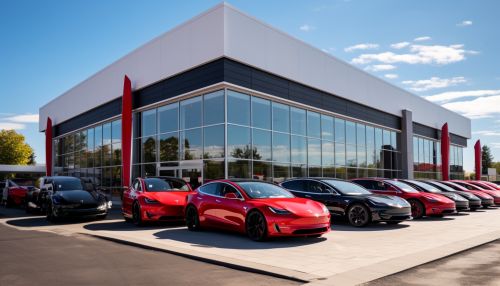Tesla Supercharger
Overview
The Tesla Supercharger network is a system of 480-volt direct current fast-charging stations built by American electric vehicle (EV) manufacturer Tesla, Inc. to enable long-distance travel for their electric cars. The network was first announced in 2012 and has since grown to include thousands of Superchargers worldwide. The Supercharger is substantially more powerful than most public charging stations, providing up to 250 kilowatts of power to recharge Tesla vehicles quickly.


Development and Deployment
Tesla began the development of the Supercharger network in 2012 to address the range limitation of electric vehicles. The company's goal was to make long-distance travel as convenient for owners of electric vehicles as it is for those with gasoline-powered cars. The first Supercharger stations were deployed in California and on the East Coast of the United States, with the aim of enabling coast-to-coast travel.
The Supercharger network has since expanded globally, with stations now located in North America, Europe, Asia, and Australia. As of 2021, there are over 25,000 Supercharger stalls at more than 2,700 stations worldwide.
Technology
The Supercharger uses a high-power direct current (DC) charging technology, which allows for faster charging times compared to conventional alternating current (AC) charging stations. The Supercharger can deliver up to 250 kilowatts of power, enabling it to recharge a Tesla vehicle to 80% in approximately 30 minutes and to 100% in around 75 minutes.
The Supercharger stations are equipped with multiple charging stalls to accommodate several vehicles at once. Each stall has a connector that plugs into a port in the Tesla vehicle to deliver the electrical charge. The connector uses a proprietary design unique to Tesla, which means that only Tesla vehicles can use the Supercharger network.
Usage
To use a Supercharger, Tesla drivers simply park their vehicle at a Supercharger station, plug in the connector, and leave the car to charge. The charging process is automatically managed by the vehicle and the Supercharger, with the vehicle's onboard computer controlling the charging rate to ensure the battery is charged safely and efficiently.
Tesla drivers can monitor the charging process and see when their vehicle is ready to drive through the Tesla mobile app. The cost of Supercharging is automatically billed to the driver's Tesla account, making the process seamless and convenient.
Impact
The Supercharger network has played a significant role in the adoption of electric vehicles by addressing one of the main concerns of potential EV buyers: range anxiety. By providing a fast and convenient way to recharge on long journeys, the Supercharger network has made electric vehicles a viable option for long-distance travel.
Furthermore, the Supercharger network has set a new standard for public charging infrastructure, demonstrating the potential of high-power DC fast charging. This has influenced other automakers and charging station operators to develop their own high-power charging networks.
Future Developments
Tesla continues to expand the Supercharger network, with plans to add more stations and increase the charging power of the Superchargers. The company is also exploring new technologies to further improve the charging experience, such as battery swapping and autonomous charging.
